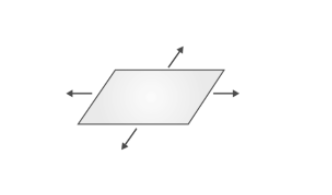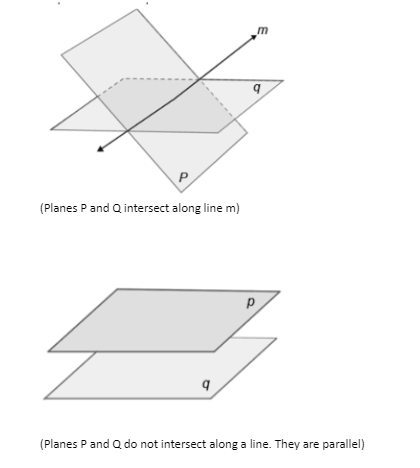In geometry, a plane is a flat surface that extends infinitely in all directions. When two planes connect, a straight line is always formed. Non-parallel planes that cross in a straight line are called intersecting planes.
The intersection of the two planes can only be on one line.
Comparing the normal vectors of the two planes can reveal a lot about their relationship. If the normal vectors are parallel, the two planes are either the same or parallel.
The two planes will meet and produce a line of intersection, which is a collection of points on both planes if the normal vectors are not parallel.
What is a plane?
To understand the intersection of two planes, we need to understand the basics of planes. In geometry, a plane extends in two dimensions indefinitely. It doesn’t have any width. In coordinate geometry, we can see an example of a plane. Points in a plane are defined by their coordinates.
A plane is a flat, two-dimensional surface in mathematics that extends indefinitely. A plane is a two-dimensional representation of a point, a line, or three-dimensional space. Planes can appear as subspaces of a few higher-dimensional spaces, such as the room’s far-reaching walls. In the framework of Euclidean geometry, these walls have their own autonomous life.

Properties of planes:
- A line can be parallel to a plane, intersect the plane at a single point, or be present in the plane.
- Two separate planes must be parallel to each other if they are perpendicular to the same line.
- Two different lines must be parallel to each other, if they are perpendicular to the same plane.
- In three-dimensional space, two independent planes are either parallel to one other or intersect in a line.
Two intersecting planes
Two planes can have one of three connections in three-dimensional space: parallel, identical, or intersecting planes.
It is possible to compare the normal vectors of the planes to learn a lot about their relationship. If the normal vectors of the two planes are parallel, they are either identical or parallel.
The two planes clash and create a line of intersection, which is a collection of points on both planes if the normal vectors are not parallel. The diagram below depicts two intersecting planes.
The intersecting line between two planes’ equations is found by determining the set of locations that satisfy the equations of both planes.
Three variables and two equations make up the planar equation (because of two planes). The intersection line’s equation is equivalent to the relationship between the three variables obtained by solving the concurrent equations.
The intersecting line between two planes’ equations is found by determining the set of locations that satisfy the equations of both planes.
Because there are three variables and two equations in the plane equation, solving the concurrent equations yields a relationship between the three variables that are identical to the intersection line’s equation.

Two Intersecting Plane Examples
- Find the point where a+b+c+1=0 and a+2b+3c+4=0 intersect.
We have a nice two intersecting plane example where two intersecting planes are generated in three dimensions and a line is formed as a result.
We require an equation that can satisfy both a+b+c+1=0 and a+2b+3c+4=0 for every (a,b,c).
Because there are two equations and three unknowns, we know we can’t solve this for a unique solution (a,b,c).
This, however, confirms our previous conclusion that the junction is a line, not a point. We’re seeking a combination of (a,b,c) that solves both equations.
It is possible to employ either the “substitution” or “elimination” strategy.
Here, the elimination approach will be used. We’ll subtract the two equations.
We get a+2b+3c+4=0 after subtracting a+b+c+1=0 from a+2b+3c+4=0
b+2c+3=0
b=2, c=3 can be rewritten as
Set c=t, where t can be any real number.
For the line’s parametrization, we’ll use the variable t as a free parameter. We can represent it in terms of t as b=2t-3 since we discovered that b=2c-3. Plugging these y and z values into one of the original equations yields an in terms of t. The first one will be used.
a=−b−c−1=2t+3−t−1=t+2.
The parametrization of the line can be written as (a,b,c)=(t+2,−2t−3,t).
Two intersecting plane questions
Following are two intersecting planes questions that might help you with your practice:
- Let r1(x) = (4−2x, 5x−2, 2x) and r2(x) = (x+1, 2x+1, x+1) be two lines. Find their point of intersection and then find the equation of the plane containing both lines.
- Let r1(x) = (x + 3, 1 − x, 3x + 3) and r2(x) = (x + 5, −x, 3x) be two parallel lines (that do not intersect). Find the equation of the plane containing both lines.
Conclusion
Planes that are not parallel and always intersect along a line are referred to as intersecting planes. There can only be one line where two planes intersect.
The two planes, P and Q, cross in a single line, XY, as shown in the diagram below. As a result, the P and Q planes are connected by the XY line. A real-life two intersecting planes example is the two connected walls.
 Profile
Profile Settings
Settings Refer your friends
Refer your friends Sign out
Sign out






